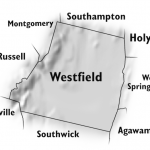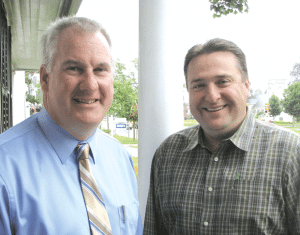Community Profile: Westfield
Westfield Takes Flight with New Jobs, Development
 When BusinessWest sat down this month with Westfield Mayor Daniel Knapik and Kate Phelon, executive director of the Greater Westfield Chamber of Commerce, it was just one more connection in what has become a strong bond between the city and its chamber.
When BusinessWest sat down this month with Westfield Mayor Daniel Knapik and Kate Phelon, executive director of the Greater Westfield Chamber of Commerce, it was just one more connection in what has become a strong bond between the city and its chamber.
Take the monthly Mayor’s Coffee Hour the chamber launched to forge a stronger relationship between the city’s leaders and its business community.
“That gives businesses and residents first-hand access to city officials,” Phelon said. “We’re very proud that we have that kind of access to the mayor; not many cities can say they do that on a regular basis.”
The mayor agrees. “We really have opened the door to businesses,” said Knapik, noting that some companies had never before approached the city about their issues.
“Manufacturing companies have different needs than small operators,” Phelon said. “It’s good that we can have this open-door policy and bring these issues in and have dialogue.”

Mayor Daniel Knapik, left, and Jeff Daley say Westfield’s investments in its infrastructure have already begun to spur more development.
“The best testimony is from folks who haven’t been in Westfield in a while,” Knapik said, “when they come into the downtown and say, ‘wow, what happened?’ And there’s more coming.”
Ready for Takeoff
They might say the same about Barnes Airport on the city’s north side, which has leveraged millions of dollars in public and private investment in the service of infrastructure upgrades and development projects.
“We’ve had multiple funding sources, at the federal, state, and city levels, to get $14 million for a new runway,” said Jeff Daley, the city’s advancement officer. “The current runway is 28 years old, which is eight years past its life expectancy. They’ll be ripping out the entire 9,500 feet of runway and rebuilding it. A large portion of the north and south end of the runway will be concrete, and the middle section will be a specialized tar pavement that will allow the F16s and other planes not to rip it up.”
The 104th Fighter Wing of the Air National Guard has been relocated to Westover Air Reserve Base and Otis Air Force Base during the project, which is expected to be completed by Thanksgiving. Daley said the new runway will attract more commercial use of the airport. Meanwhile, Rectrix Aviation, which bought out Airflyte, is working to increase its investment at Barnes to bring a wider range of services to its clients.
Meanwhile, Daley said, “we obtained a grant from the state to redesign and rebuild Airport Industrial Park Road. It was a $2 million grant, and we’re returning $800,000 back to the state; we managed to do it with $1.2 million. We made it safer with a full redesign; the hairpin turn there was dangerous. We paved it, and we’ll have some new signage to alert people to come to the industrial park.”
That’s where the city is developing 80 acres — perhaps 12 to 15 subdivided lots — for light-manufacturing and aviation-supported businesses. “We’ve had serious conversations with four or five companies looking there, waiting for the road to be finished,” Daley said.
“Add to that Gulfstream’s expansion, and we think Barnes is in a position of growth, with the most action we’ve seen there in years,” Knapik said, noting that the airport is on the cusp of generating more revenue than the city is investing in it. “We’re close to breaking even now, and some of the other situations coming to light will add more revenue to the city. It took a long time to bring it to break-even status.”
Speaking of breaking even, the mayor said, one of the best stories in the city recently is the turnaround of Noble Hospital. After seven years running a deficit, it was able to turn a profit last year.
“It’s great what they’ve been able to do, to modernize the hospital and open up space that had been shuttered and really find niche services for our community, from gastroenterology to expanding the breast-cancer unit,” he continued. “When I came into office, it was pretty dire over there, but it’s been astounding. They’ve been able to invest in their physical plant and turn a profit, which is great news. They seem to be in position for a pretty strong future now.”
Bridges to Progress
So does the downtown area, following a $14.5 million reconstruction of Main and Broad streets and the Park Square Green, and the four-year Great River Bridge project that paired the renovation of that span, over the Westfield River, with the construction of a second bridge next to it.
Those successes will be followed by a significant commercial development at Elm and Arnold streets, featuring a 130,000-square-foot mixed-use facility, a 2,000-square-foot transportation center, and a five-story parking garage. Daley pegged completion of the project — which has been discussed in some form or other for decades — for 2015 or 2016.
“There have been lots of iterations to it,” he said, noting that the city would like the mixed-use facility to include retail, restaurants, and office space. As for the parking garage, “we’re fortunate to have parking problems, and we’re developing up to 500 new spaces to make it a more attractive prospect to come downtown and shop and have dinner.”
The mayor is excited by the prospects. “We’ve said for years that, if the city took care of its property and infrastructure, which we’ve been doing, the rest will follow,” Knapik said of the proposal, and the hope that it will continue a downtown revitalization that has already seen a number of new businesses open on that stretch of Routes 10 and 202.
Those include eateries and a copy center, businesses that will cater to a growing number of college students living downtown following the conversion of the Lansdowne building on Thomas Street into a 216-bed dormitory for Westfield State University. In addition, the former WSU training school building on Washington Street is being redeveloped into privately owned market-rate housing, which would add more student life to Westfield’s downtown.
“We’ve already seen the opening of many new downtown businesses that cater to the young folks living downtown,” Knapik said, including three restaurants with outdoor seating.
“With the City Council allowing outside seating, that’s a first for Westfield,” Phelon said. “I don’t think we’ve ever had that before. Now people will see people sitting and eating outside,” creating more energy downtown.
The city is also moving forward with plans for the riverfront area on the south side of town, which may include a mix of uses. “We’re reviewing four concepts now, and we’ll unveil those to the public over the next two months or so,” said Knapik, who would like to see that project connect with the Columbia Greenway Rail Trail. “These are all things that have been kicked around the city for 20 years or so, and they’re all starting to click now, so we’re happy about that.”
Challenges Remain
Knapik said the city’s unemployment rate, hovering between 6.5% and 6.8%, “isn’t bad, but we need it to be better to really knock us out of the economic slowdown we’re in. But we feel like, with the diverse base we have — including military, healthcare, precision machining, and warehousing — we’re seeing excellent growth in some areas.”
Daley noted that, since 2010, the city has attracted more than $120 million in private investment and has another $72 million in the pipeline. “Currently, 7,000 jobs have been retained by those efforts, and 800 new jobs over three years. There’s a pretty good story to tell there. We’re working very hard to keep retention up … and to make Westfield a place where people want to grow and stay.”
Phelon said the city is working to cultivate its creative economy in an organized way, as nearby communities such as Northampton, Easthampton, and Holyoke have done. “We’re in the infant stages of this. We applied for a grant to take inventory of the creative economy in the city. That can drive economic development, and the chamber is happy to be a part of that.”
The idea, Knapik said, is to bring different “puzzle pieces” that make up the city’s economy out of their individual silos and into an organized effort to promote Westfield’s vitality.
The mayor also touted the city’s efforts to keep property taxes lower than in some surrounding cities and towns. “We want to be that business-friendly community.”
It has tried to do so at a time when state aid to cities is low — in Westfield’s case, down about 30% since before the recession. Yet, plenty of investment continues, giving the mayor plenty to talk about at those coffee hours.
“It’s good,” he said of that communication. “A lot of times, policy is made in an echo chamber. This way, we ensure that both sides are heard. We hear them, and they hear us.”
Joseph Bednar can be reached at [email protected]




